jumpincactus
Premium Member
Supporter
- 11,609
- 438
I'm sure some of you are already hip to this method, but I am also sure a noobie will come across it at some point.
Cant get much more organic than this as compared to buying store bought hormones for inflated prices from a hydro or garden center. It's free for those that have access to willow trees. I tried the method this season and I must say it works rather well. I used the Weeping Willow genus.
Here is the link for the write up and recipe. Very very simple and can be stored for a month. I use Rapid Rooters or Rock Wool cubes. This gal uses cuttings straight into to soil. I also at the time of cloning use a little mycho powder in the cube or RR.
Enjoy and go organic!!!
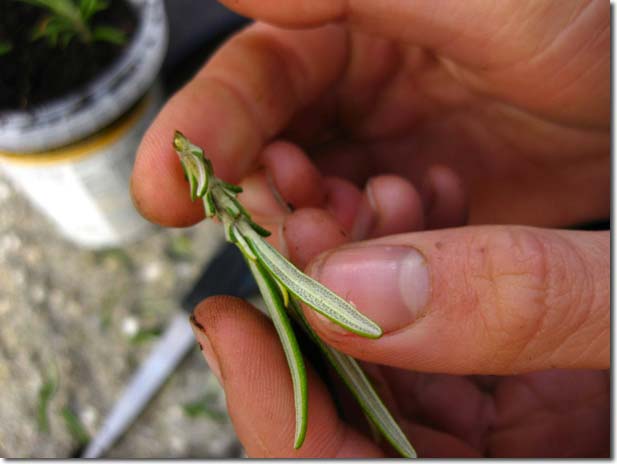
There are many ways to propagate plants, which can be broadly divided into sexual and asexual. Taking cuttings is an asexual method, as your new plants will be clones of the mother. The method is simply to cut a new shoot from an existing plant and encourage it to take root itself. Information abounds about which plants are best to take cuttings from, and how to go about the process, but not all of it agrees, so I decided to make my own experiment.
Natural rooting hormone
Many plants need a little help to grow roots, although some species can be planted straight into the ground. One of these is willow (salix spp.), and an effective way of capturing the rooting hormone present in willow for use on other plants is to make willow water.
This willow water recipe is based on one I learnt during my PDC at Permaship in Bulgaria.
My willow water recipe
Ingredients:
You are only looking for the very tips on the branches, where the growth is newest. I cut about 10cm from the end of the branches.
You do not need many to make an effective rooting hormone. About five-ten 10cm branch-ends is plenty.
Step 2: remove the leaves
Cut all the leaves off the branches so that you are left with just the thin, springy shoots. The leaves can be discarded or, if you are that way inclined, dried for use as tea — see for example (1) for uses of willow tea: Weeping Willow, salix babylonica, is an especially potent species.
Step 3: chop up the branches
Now that you just have the branches left, chop them up very small and place them in a large bowl or container. Ideally the smaller the pieces of branch the better. I left mine a couple of cms long.
Step 4: watering the willow
Now fill the container with water, so that all of your chopped-up bits of willow are completely covered. Place a lid of some kind on top of the container, and leave it to stand for about 2 nights, to allow all of the rooting hormone to soak out of the bits of willow and into the water.
If you are using a plastic container to soak the willow in, it is possible that some of the plastic will leach out and become present in the rooting hormone (see for example 2). However, this does not necessarily mean that the rooting hormone will not be effective.
Step 5: decant the potion
Once it has been left for a couple of days, separate the water from the branches using a sieve. Do not be alarmed if the resulting potion smells a little unpleasant; this is for plants to drink, not you, so there’s no need to worry.
Now the willow water is ready for use and you can put it into a bottle using the funnel. Again, the concerns about plastic are relevant here (see for example 2).
Once you have the willow water in a suitable container, it can be kept for some weeks in a dry dark place, and up to two months if kept in a refrigerator.
Using your potion for propagation
Now the willow water is ready for its purpose: to use as a natural rooting hormone, to help cuttings to take root. This is a simple process, which I think you will find success with too if you follow more or less the same steps as me.
Ingredients:
Step 1: Prepare the plants’ new home
Decide how many new plants you wish to make, and fill up the appropriate number of plant pots with seed compost. If you are making your own seed compost, mix this before you put it in the plant pots.
Step 2: Choose your clones
Taking your scissors, approach the mother plant of your choice. I looked for the new growths at the very tip of the branches. I cut these off at about 5cm long, using a diagonal cut, in order to maximise the surface area of the bottom of the cutting: the part where the new roots will form.
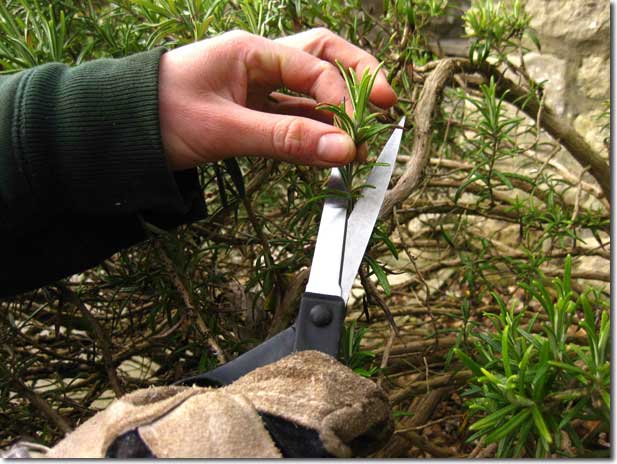
Choosing your cuttings
 Diagonal angle is optimal
Diagonal angle is optimal
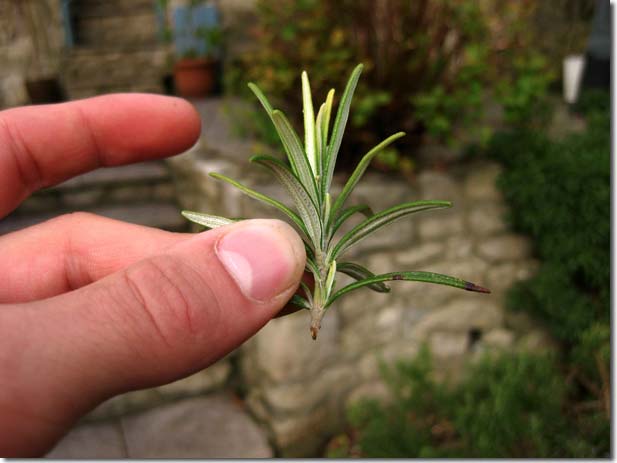 A good height for the new cutting
A good height for the new cutting
Step 3: Remove bottom leaves
Most of the end of the cutting is going to turn into new root growth underground, so you do not want the plant to be putting too much energy into the leaves, or for the leaves to be too close to the compost so that they rot. With this in mind, I carefully cut away all but the topmost two sets of leaves from the cutting; leaving a bare stem of around 3cm in length. I left the top layers of leaves so that the new plant can still photosynthesise.
Step 4: Apply the hormone
Now you can add willow water in order to encourage root growth. You do not need much: I simply poured a tiny amount of the willow water into a bottle cap, and then, taking the cuttings one by one, dipped them into this potent pool.
If you prefer you can wait until the cuttings are planted and apply a few drops of willow water to the base of the stems. Be careful: again, three drops is plenty.
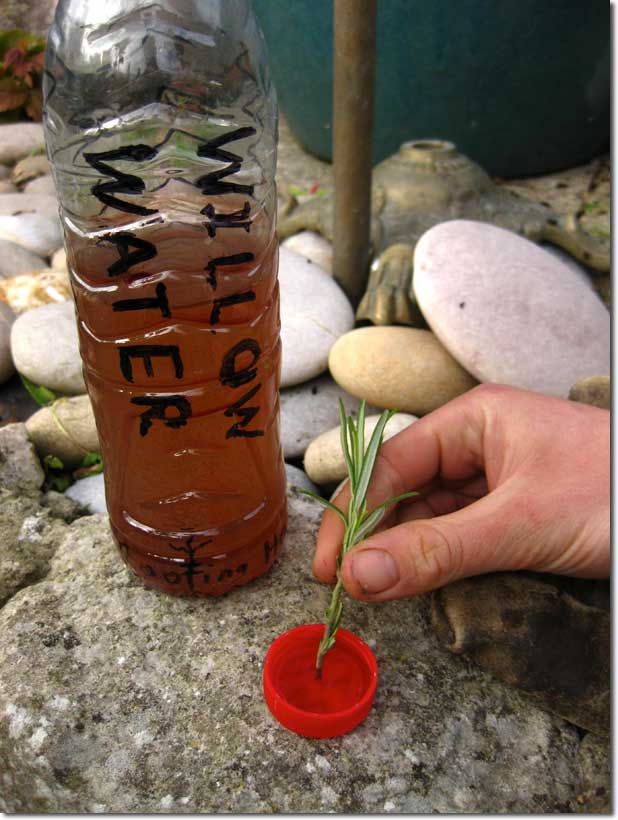 Dipping the cutting in the willow water
Dipping the cutting in the willow water
Step 5: Into the pot
Now you can place the cuttings in their new home. I used my finger to carefully poke a little dip, about the depth of my first finger-joint, into the top of the seed compost. Then I took the cutting, placing it gently in the centre of the dip, and loosely filled in the dip with seed compost.
It is important to be sensitive when re-filling the earth.
Step 6: water and go!
Carefully water your new clones. I find a gentle method is to poke holes in the lid of a small plastic bottle and fill this with water, which can then be squirted onto fragile new plants without damaging them.
The cuttings should now start to take root.
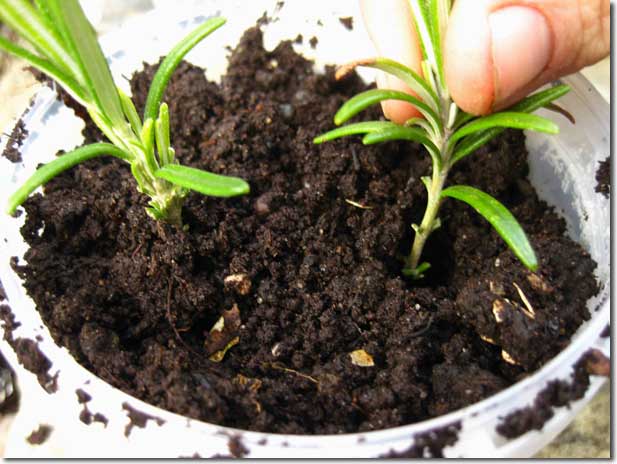 Placing the cuttings in the seed compost
Placing the cuttings in the seed compost
Here are the cuttings I made one month later. Note the new growth at the base of each leaf.
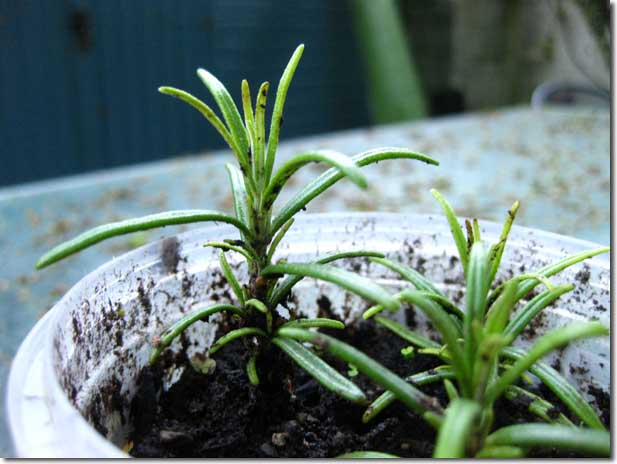 One month later – with new growth!
One month later – with new growth!
Clearly, the plants have taken root: so from this I conclude that the rooting hormone was effective. However, there is a possibility that the rosemary would have taken root anyway, so I am tempted to make another experiment trying two sets of cuttings; one with and one without the willow water.
Either way, I am happy with my new cuttings so far, as I’m sure you will you be when you try your own experiments.
Update: Willow Water Recipe: Some more accurate measurements
Following some queries (via comments below) on my willow water recipe, I have noted down some more accurate measurements.
I feel it also worthwhile to mention that although this recipe is one I personally made, the concept of willow water being used as a rooting hormone has been around much longer and I did not invent it (as I said in my article, I learned the recipe at Permaship in Bulgaria, but there are many more sources all over the world) and I wrote the article more as an instructive guide for how to make it than as some kind of proof that it works.
What size branches to use?
The sticks I used were from the very tips of the branches – the particular tree from which I obtained my willow was a weeping willow (Salix Babylonica), and some of the branches which I cut were actually trailing on the ground. It was only the very young growth at the end of the branches that I was interested in.
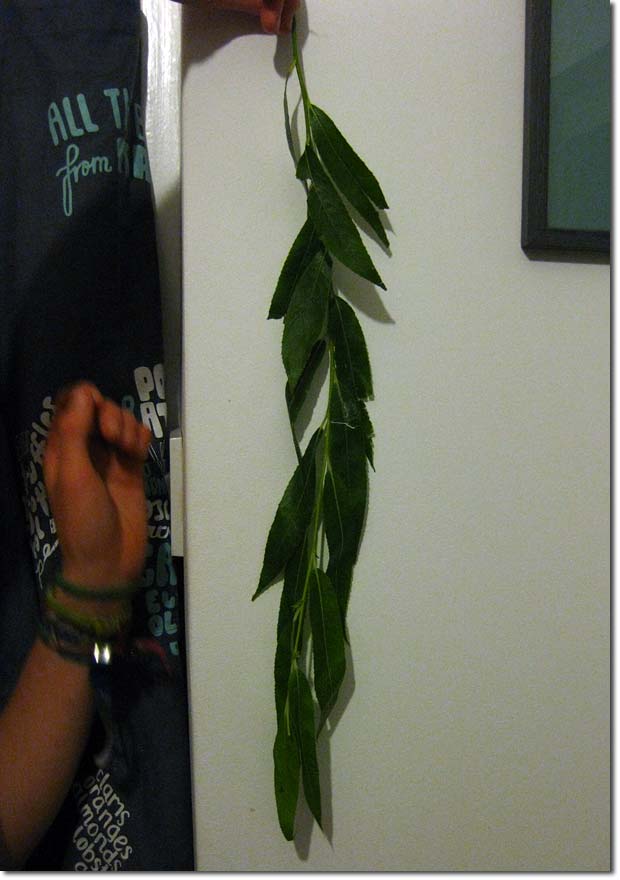
A good example of a young shoot.
(This, and following photos, by David Ashwanden)
Where willow becomes water
Once I had stripped the shoots of leaves, I then chopped them up into a bowl ready to be weighed. You can see the size of the pieces here:
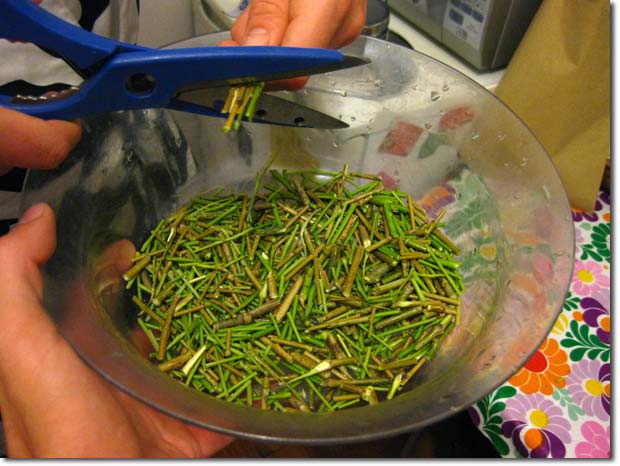
Cutting the pieces of willow
As I said previously, the size is not strictly important, but it’s intuitive that the smaller the pieces are the faster the active ingredient can seep out into the water.
Having weighed the willow I collected, I made this ratio: 200g willow: 1 litre water.
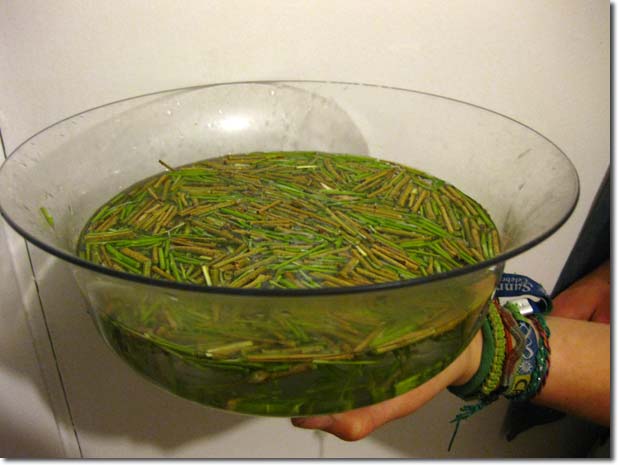
My proportion of willow water
So here is my recommendation for a willow water recipe: for every 100g of willow, add 500ml of water.
I encourage you to all keep experimenting yourselves.
References:
Cant get much more organic than this as compared to buying store bought hormones for inflated prices from a hydro or garden center. It's free for those that have access to willow trees. I tried the method this season and I must say it works rather well. I used the Weeping Willow genus.
Here is the link for the write up and recipe. Very very simple and can be stored for a month. I use Rapid Rooters or Rock Wool cubes. This gal uses cuttings straight into to soil. I also at the time of cloning use a little mycho powder in the cube or RR.
Enjoy and go organic!!!

There are many ways to propagate plants, which can be broadly divided into sexual and asexual. Taking cuttings is an asexual method, as your new plants will be clones of the mother. The method is simply to cut a new shoot from an existing plant and encourage it to take root itself. Information abounds about which plants are best to take cuttings from, and how to go about the process, but not all of it agrees, so I decided to make my own experiment.
Natural rooting hormone
Many plants need a little help to grow roots, although some species can be planted straight into the ground. One of these is willow (salix spp.), and an effective way of capturing the rooting hormone present in willow for use on other plants is to make willow water.
This willow water recipe is based on one I learnt during my PDC at Permaship in Bulgaria.
My willow water recipe
Ingredients:
- Fresh willow branches – use the very ends of the branches where growth is newest
- Sharp scissors
- Large bowl or container (preferably not plastic)
- Sieve
- Funnel (optional)
- Bottle for storage (again, preferably not plastic)
You are only looking for the very tips on the branches, where the growth is newest. I cut about 10cm from the end of the branches.
You do not need many to make an effective rooting hormone. About five-ten 10cm branch-ends is plenty.
Step 2: remove the leaves
Cut all the leaves off the branches so that you are left with just the thin, springy shoots. The leaves can be discarded or, if you are that way inclined, dried for use as tea — see for example (1) for uses of willow tea: Weeping Willow, salix babylonica, is an especially potent species.
Step 3: chop up the branches
Now that you just have the branches left, chop them up very small and place them in a large bowl or container. Ideally the smaller the pieces of branch the better. I left mine a couple of cms long.
Step 4: watering the willow
Now fill the container with water, so that all of your chopped-up bits of willow are completely covered. Place a lid of some kind on top of the container, and leave it to stand for about 2 nights, to allow all of the rooting hormone to soak out of the bits of willow and into the water.
If you are using a plastic container to soak the willow in, it is possible that some of the plastic will leach out and become present in the rooting hormone (see for example 2). However, this does not necessarily mean that the rooting hormone will not be effective.
Step 5: decant the potion
Once it has been left for a couple of days, separate the water from the branches using a sieve. Do not be alarmed if the resulting potion smells a little unpleasant; this is for plants to drink, not you, so there’s no need to worry.
Now the willow water is ready for use and you can put it into a bottle using the funnel. Again, the concerns about plastic are relevant here (see for example 2).
Once you have the willow water in a suitable container, it can be kept for some weeks in a dry dark place, and up to two months if kept in a refrigerator.
Using your potion for propagation
Now the willow water is ready for its purpose: to use as a natural rooting hormone, to help cuttings to take root. This is a simple process, which I think you will find success with too if you follow more or less the same steps as me.
Ingredients:
- The mother plants – whatever it is you wish to clone. Cloning using cuttings is possible with many, if not all, plant species, both annual and perennial, although some are easier to propagate in this manner than others. For this experiment I used rosemary (rosmarinus officinalis)
- Some seed compost, or home-made seed compost mix, for example 1 part compost, 1 part sand, 1 part coir
- Your bottled willow water
- Plant pots
- Scissors
Step 1: Prepare the plants’ new home
Decide how many new plants you wish to make, and fill up the appropriate number of plant pots with seed compost. If you are making your own seed compost, mix this before you put it in the plant pots.
Step 2: Choose your clones
Taking your scissors, approach the mother plant of your choice. I looked for the new growths at the very tip of the branches. I cut these off at about 5cm long, using a diagonal cut, in order to maximise the surface area of the bottom of the cutting: the part where the new roots will form.

Choosing your cuttings


Step 3: Remove bottom leaves
Most of the end of the cutting is going to turn into new root growth underground, so you do not want the plant to be putting too much energy into the leaves, or for the leaves to be too close to the compost so that they rot. With this in mind, I carefully cut away all but the topmost two sets of leaves from the cutting; leaving a bare stem of around 3cm in length. I left the top layers of leaves so that the new plant can still photosynthesise.
Step 4: Apply the hormone
Now you can add willow water in order to encourage root growth. You do not need much: I simply poured a tiny amount of the willow water into a bottle cap, and then, taking the cuttings one by one, dipped them into this potent pool.
If you prefer you can wait until the cuttings are planted and apply a few drops of willow water to the base of the stems. Be careful: again, three drops is plenty.

Step 5: Into the pot
Now you can place the cuttings in their new home. I used my finger to carefully poke a little dip, about the depth of my first finger-joint, into the top of the seed compost. Then I took the cutting, placing it gently in the centre of the dip, and loosely filled in the dip with seed compost.
It is important to be sensitive when re-filling the earth.
Step 6: water and go!
Carefully water your new clones. I find a gentle method is to poke holes in the lid of a small plastic bottle and fill this with water, which can then be squirted onto fragile new plants without damaging them.
The cuttings should now start to take root.

Here are the cuttings I made one month later. Note the new growth at the base of each leaf.

Clearly, the plants have taken root: so from this I conclude that the rooting hormone was effective. However, there is a possibility that the rosemary would have taken root anyway, so I am tempted to make another experiment trying two sets of cuttings; one with and one without the willow water.
Either way, I am happy with my new cuttings so far, as I’m sure you will you be when you try your own experiments.
Update: Willow Water Recipe: Some more accurate measurements
Following some queries (via comments below) on my willow water recipe, I have noted down some more accurate measurements.
I feel it also worthwhile to mention that although this recipe is one I personally made, the concept of willow water being used as a rooting hormone has been around much longer and I did not invent it (as I said in my article, I learned the recipe at Permaship in Bulgaria, but there are many more sources all over the world) and I wrote the article more as an instructive guide for how to make it than as some kind of proof that it works.
What size branches to use?
The sticks I used were from the very tips of the branches – the particular tree from which I obtained my willow was a weeping willow (Salix Babylonica), and some of the branches which I cut were actually trailing on the ground. It was only the very young growth at the end of the branches that I was interested in.

A good example of a young shoot.
(This, and following photos, by David Ashwanden)
Where willow becomes water
Once I had stripped the shoots of leaves, I then chopped them up into a bowl ready to be weighed. You can see the size of the pieces here:

Cutting the pieces of willow
As I said previously, the size is not strictly important, but it’s intuitive that the smaller the pieces are the faster the active ingredient can seep out into the water.
Having weighed the willow I collected, I made this ratio: 200g willow: 1 litre water.

My proportion of willow water
So here is my recommendation for a willow water recipe: for every 100g of willow, add 500ml of water.
I encourage you to all keep experimenting yourselves.
References:
- Plants For A Future, 2014. “Database entry: Salix Babylonica – L”.http://pfaf.org/user/Plant.aspx?LatinName=Salix+babylonica
- Shotyk et al, 2006. “Contamination of Canadian and European bottled waters with antimony from PET containers”. Journal of Environmental Monitoring: 2006, 8, 288 – 292.





